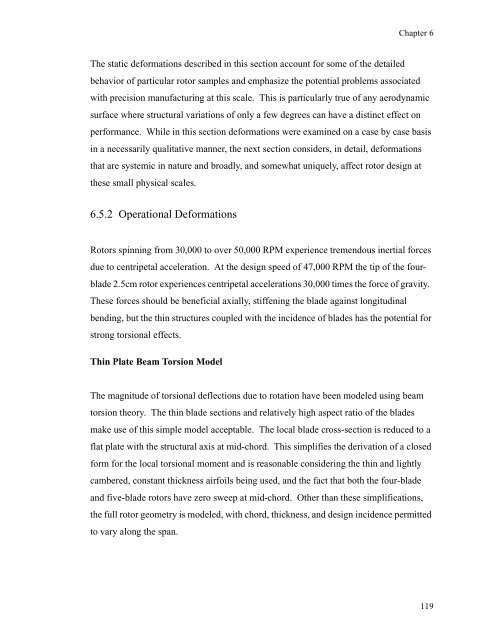Aerodynamics and Design for Ultra-Low Reynolds Number Flight
Aerodynamics and Design for Ultra-Low Reynolds Number Flight
Aerodynamics and Design for Ultra-Low Reynolds Number Flight
Create successful ePaper yourself
Turn your PDF publications into a flip-book with our unique Google optimized e-Paper software.
The static de<strong>for</strong>mations described in this section account <strong>for</strong> some of the detailed<br />
Chapter 6<br />
behavior of particular rotor samples <strong>and</strong> emphasize the potential problems associated<br />
with precision manufacturing at this scale. This is particularly true of any aerodynamic<br />
surface where structural variations of only a few degrees can have a distinct effect on<br />
per<strong>for</strong>mance. While in this section de<strong>for</strong>mations were examined on a case by case basis<br />
in a necessarily qualitative manner, the next section considers, in detail, de<strong>for</strong>mations<br />
that are systemic in nature <strong>and</strong> broadly, <strong>and</strong> somewhat uniquely, affect rotor design at<br />
these small physical scales.<br />
6.5.2 Operational De<strong>for</strong>mations<br />
Rotors spinning from 30,000 to over 50,000 RPM experience tremendous inertial <strong>for</strong>ces<br />
due to centripetal acceleration. At the design speed of 47,000 RPM the tip of the four-<br />
blade 2.5cm rotor experiences centripetal accelerations 30,000 times the <strong>for</strong>ce of gravity.<br />
These <strong>for</strong>ces should be beneficial axially, stiffening the blade against longitudinal<br />
bending, but the thin structures coupled with the incidence of blades has the potential <strong>for</strong><br />
strong torsional effects.<br />
Thin Plate Beam Torsion Model<br />
The magnitude of torsional deflections due to rotation have been modeled using beam<br />
torsion theory. The thin blade sections <strong>and</strong> relatively high aspect ratio of the blades<br />
make use of this simple model acceptable. The local blade cross-section is reduced to a<br />
flat plate with the structural axis at mid-chord. This simplifies the derivation of a closed<br />
<strong>for</strong>m <strong>for</strong> the local torsional moment <strong>and</strong> is reasonable considering the thin <strong>and</strong> lightly<br />
cambered, constant thickness airfoils being used, <strong>and</strong> the fact that both the four-blade<br />
<strong>and</strong> five-blade rotors have zero sweep at mid-chord. Other than these simplifications,<br />
the full rotor geometry is modeled, with chord, thickness, <strong>and</strong> design incidence permitted<br />
to vary along the span.<br />
119




